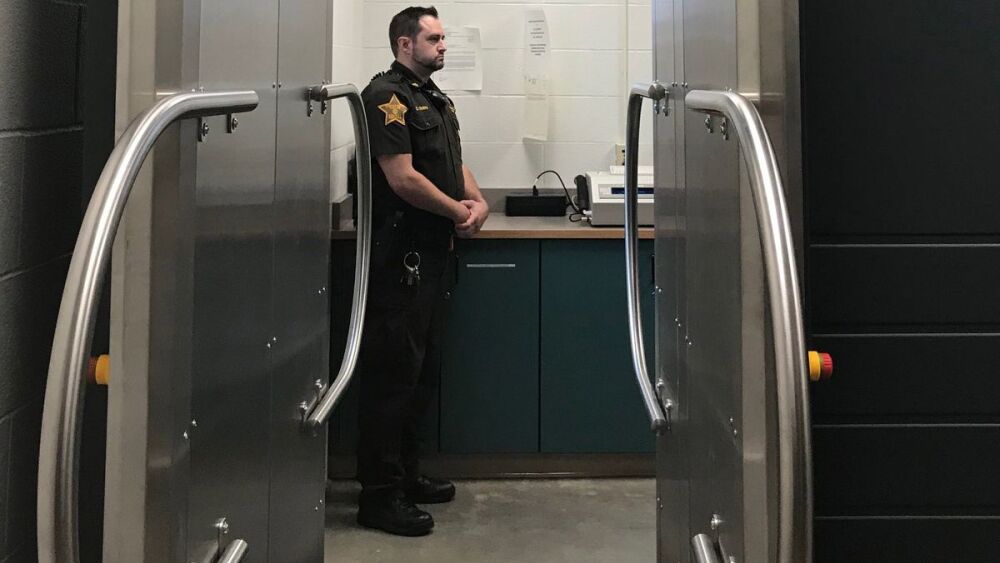Sponsored by Smiths Detection
By Rachel Zoch, Corrections1 BrandFocus Staff
Drugs and other contraband are a challenge for any correctional facility, and stopping these illicit items before they enter is a key strategy for success. To that end, sheriffs’ departments across Indiana are adopting X-ray body scanners to help keep contraband, especially drugs, out of their jails.
The Wayne County Sheriff’s Office in Richmond (between Indianapolis to the west and Dayton, Ohio, to the east), serves a population of about 67,000 people and accepts arrestees from several jurisdictions in the area. The average daily population of the 416-bed jail is about 330 inmates, supervised by a staff of 17 COs, 25 deputized staff and eight jail supervisors.
Capt. Andrew Abney-Brotz, WCSO jail commander, says drugs in the jail have always been a problem, and the WCSO wanted a tool to help better address the issue. He knew other counties had started screening inmates at intake with X-ray scanning.
“During shakedowns, we always find contraband, including drugs,” said Abney-Brotz. “We knew a couple of sheriffs in Indiana that had the body scanner, and we wanted to incorporate that into our facility.”
Shakedowns at the Wayne County Jail are performed at random, as in most facilities. COs regularly find things like tobacco and lighters, or batteries missing out of the TV remotes.
“But we were finding more severe things, such as heroin and fentanyl, inside the jail that had made it back to the inmate population. And with the growing concern of fentanyl and carfentanil and just the severity of drugs these days, we wanted to get something to start looking for those items at the door,” he said. “We didn’t want cell phones to come into the jail. We didn’t want weapons to come into the jail. We hadn’t found any of those items other than the drugs, but we wanted something to help identify those things.”
‘A PERFECT FIT’
So while attending the National Sheriffs’ Association Conference and the American Jail Association Conference in 2019, Abney-Brotz and his colleagues looked at body scanners. They liked what the Smiths Detection B-SCAN had to offer and reached out to the supplier, Command Sourcing, to do a site survey to see if the B-SCAN would fit where they wanted the equipment to be.
“It just seemed like a perfect fit,” he said.
Abney-Brotz says the B-SCAN fits seamlessly into their intake screening, adding less than a minute to the overall process. It takes about 10 seconds to input an individual’s data before the scan and another 7 seconds to complete a scan, he says, and the machine is simple to operate.
“It’s a pre-booking tool, so when an arrestee comes into the jail with the arresting officer, the first thing they encounter is the body scanner,” he said. “If we identify things that are abnormal, we can strip search the individual. If we don’t find anything during the strip search, then we refer them to the hospital.”
They anticipated some pushback because in the latter case, the arresting agency has to take the individual to the hospital to get a further checkup. But that doesn’t happen often, says Abney-Brotz.
“Anytime you introduce anything into corrections or a jail booking process it’s going to affect more than just jail staff – it’s going to affect the arresting agencies,” he said. “There was a lot of kickback from our local agencies about the scanner and possibly having to take more people out to the hospital.”
To address this concern, the WCSO hosted a meeting of all the police chiefs in the county to explain what the scanner does and how it would be used. The chiefs were asked to spread the word to their patrol staff that jail staff have been trained to look for specific things and will send somebody to the hospital only when necessary – such as when someone fesses up to swallowing a drug parcel or to identify a foreign object detected in the body by the scanner.
“In the two and a half months since we’ve been in operation with the scanner, we’ve scanned 992 times and we have found probably 20 or 30 items of contraband,” said Abney-Brotz. “Inside those 992 times, we have probably referred 20 people to the hospital if we can’t identify or if the individual has admitted they’ve ingested some sort of drugs.”
RAPID RESULTS
Already the WSCO has spotted several hidden parcels of dangerous drugs thanks to the B-SCAN.
“Just today we found a couple of baggies of meth on a female that came in. She had it tucked inside of her pant waistband,” said Abney-Brotz. “We have found bags of fentanyl inside people, which was really concerning. We isolated that individual in a holding cell, and we were finding bags of fentanyl when we would go and check this individual, so that was a good find. They had been out to the hospital already, and the hospital confirmed that the individual did ingest something, they just couldn’t identify what. So that’s when we isolated the individual and started finding those things.”
Several individuals, upon seeing the scanner, have admitted they have contraband before being screened.
“Knowing that we have the scanner is a big deterrent” said Abney-Brotz. “The public is well aware that we have the scanner, so when they step up onto the conveyor to be scanned, they will tell us, ‘Hey, I have a syringe in my pants,’ or ‘I have something concealed that you might want.’ So that’s been a big win for us as well.”
Also, they have found less contraband during shakedowns since the scanner was installed.
“We find little things, things that they make while they’re here that are considered contraband,” said Abney-Brotz, “but as far as any outside influence, I don’t think we have found much, if any.”














